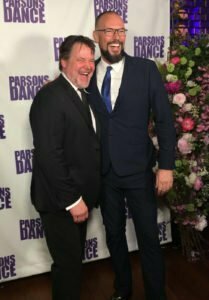I have never really thought of legacy as important.
I have mostly considered it a misguided attempt at the invention of immortality. Perhaps you could exact even a great influence that penetrates the iron walls of death for a time, but at best, we will all be forgotten in a few generations, if not in name, at least in any shred of meaningful retelling.
Legacy was certainly a big part of being part of Houston Ballet. Whatever Ben Stevenson’s mark on the greater dance world may have been, his influence within our company culture was enormous. I have throughout my life felt the effects of what was unique about learning from him. But the next step beyond that feels like a frayed end. It’s like tools that are available in my toolbox, but there is a heaviness and finality to how they might carry into the future. They have already become something else for me.
I have often wondered what the rippling effects of having made Trey McIntyre Project will be. Being so geographically isolated in Boise, Idaho, it is perhaps harder to gauge what affect it will have into the future.

I had lunch this week with former TMP dancer Chanel DaSilva. She staged Ma Maison for me on Parson’s Dance before they opened it this week at The Joyce Theater. The first time moving from the position of mentee to being a colleague with someone who has been important in one’s life is an important milestone. I remember it the first for for myself as this combination of giddy achievement and growth but also the wide-eyed vertigo of increased accountability and expectation.
I also imagined it as a gift bestowed upon me by a mentor in a moment of generosity.
But sitting here with Chanel today, I saw it quite differently. It was happening not by my choice, but instead quite organically because of who Chanel has become and maybe even because of who I have become. It felt like I was the one being given a gift because this person in whom I had invested so much was now releasing me of the absolute duty in the out of balance relationship similar to parent/child and she was becoming my respected friend.
 She spoke with great understanding and insight and depth about the things she had learned from me as she was a dancer, what part of my own legacy was continuing through her, and spoke with the insight of knowing things more from a shared perspective as she spends more time in the front of the room. I can see into the future all of the students at LaGuardia High School (where she teaches) having the same exchange with her one day and how the tentacles of the way we taught and shared with each other created our history.
She spoke with great understanding and insight and depth about the things she had learned from me as she was a dancer, what part of my own legacy was continuing through her, and spoke with the insight of knowing things more from a shared perspective as she spends more time in the front of the room. I can see into the future all of the students at LaGuardia High School (where she teaches) having the same exchange with her one day and how the tentacles of the way we taught and shared with each other created our history.
I have certainly looked up to David Parsons throughout my career. He is so bold in making dance that speaks to the very important and malnourished experience of feeling undamable joy, and surprise. I cringe when I hear the word “accessible” to describe art because it simultaneously implies that audiences are generic and not smart (accessible carries the implication of “dumbed down”) and also undermines the possibility of richness in experience of complex work. All art is accessible unless it is locked away. The question is more if audiences are accessible.
The first time I saw Parsons Dance I felt at home and knew I wanted to get closer to that. I told my friends that one day I would work with that company and they told me to give it up because Parsons Dance only performs David Parsons’s work.
 Still, David’s work was a definite influence on me as a young choreographer and as I gained more access and learned about his roots within the legacy of Paul Taylor, the weaving of influence I was benefitting from made great sense to me. Here I am, many years later and consider Dave a trusted friend and colleague.
Still, David’s work was a definite influence on me as a young choreographer and as I gained more access and learned about his roots within the legacy of Paul Taylor, the weaving of influence I was benefitting from made great sense to me. Here I am, many years later and consider Dave a trusted friend and colleague.
At the opening night party for Your Flesh Shall be a Great Poem at San Francisco Ballet, I met a former Paul Taylor dancer. We were going through the list of close and tangential connections we had and I shared with her that Parson’s Dance would be performing Ma Maison. I shared with her what a big accomplishment this felt like and how in awe I am of the big picture history of all of these amazing artists and she said, ”and now you’re a part of that legacy.”
My life up to this moment had been like a vine, growing up the side of a house reaching toward sunlight and I could now see how the whole wall below me had been painted with complex, ecstatic winding leaves.
One’s legacy is not a stone memorial to winning or being the most special
it is playing our unique parts in the great chain of history…that our goodness, pain, and love will fracture, separate and multiply to become vital parts in the vast organism of humanity. It is what we connect to and how we make things possible for each other. It is not “what did I do as an individual?” but rather “how did I fulfill my part to support all of life?” Our legacy is our humanity. We create what endures, together.










